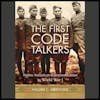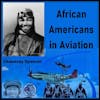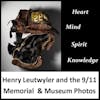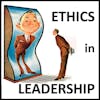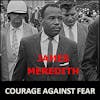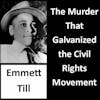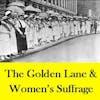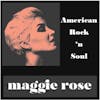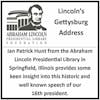Gobsmacked at the Sight: The 1904 St. Louis World's Fair
This episode features Patrick Murphy, a renowned author, television producer, and media personality, discussing his latest book Prelude to a Century: The 1904 St. Louis World's Fair; aka the Louisiana Purchase Exposition. Murphy shares insights into the World's Fair's historical significance, including its architectural marvels, technological innovations, and cultural impact. The fair, celebrated for its grand scale and achievements, attracted 22 million visitors and showcased inventions that foreshadowed modern advancements.
Murphy also highlights lesser-known aspects, such as the controversial exhibition of indigenous peoples and other ethical concerns. The episode delves into Murphy's research process, revealing previously unseen photographs and stories discovered in archives. The conversation also touches on the fair's enduring legacy in St. Louis, encouraging a reflection on the city's potential and historical accomplishments.
[00:00] Welcome to St. Louis in Tune: Exploring the St. Louis World's Fair
[01:28] Returning to Civility: Travel Tips and Etiquette
[02:14] Special Guest Patrick Murphy: A St. Louis Media Icon
[02:37] Diving into 'Prelude to a Century': The 1904 World's Fair Unveiled
[03:18] Patrick Murphy's Journey: From Media to Authorship
[15:06] Exploring the Pike: The Heart of the 1904 World's Fair
[20:00] Reflecting on the Fair's Legacy and Its Impact on the Future
[25:36] Exploring the Dred Scott Heritage Foundation's Mission
[28:15] Diving Into the 1904 St. Louis World's Fair with Patrick Murphy
[28:53] Unveiling the Dark Side of the World's Fair: Infant Incubators and Human Exhibits
[30:50] Patrick Murphy's Book Tour and Writing Journey
- (check with the event venue for confirmation a few days ahead)
- Thursday, April 11 – Book Launch at the Missouri History Museum
- Saturday, April 13 from 1 – 3 p.m. Webster Books; 27 N. Gore, Webster Groves, MO 63119
- Sunday, April 14 from 1 – 3 p.m. Main Street Books; 307 S Main St, St Charles, MO 63301
- Saturday, April 27 from 12 – 2 p.m. Kerry Cottage; 113 N Kirkwood Rd, Kirkwood, MO 63122
- Sunday, April 28 from 3 – 6 p.m. Campbell House; 1508 Locust St, St. Louis, MO 63103
- Tuesday, May 7; Washington Missouri Library; 410 Lafayette St, Washington, MO 63090
[33:49] Reimagining St. Louis: The Legacy of the 1904 World's Fair
[42:56] Reflecting on St. Louis' Past and Future Through the Lens of the World's Fair
[47:50] Closing Thoughts and Invitation to Explore Further
- Candy Men
- Missouri History Museum - World's Fair Exhibit (04/27/2024 - 04/30/2030)
- Patrick Murphy Author
- Reedy Press
This is Season 7! For more episodes, go to stlintune.com
#stlouisworldsfair #1904worldsfair #mohistory #louisianapurchaseexposition #1904stlouisworldsfair #incubator #icecreamcone #jello #construction #wirelesstelephone #earlyautomobiles #washingtonuniversity #meetmeinstlouis #ferriswheel
Thank you for listening. Please take time to rate us on Apple podcasts,
Podchaser, or your favorite podcast platform.
Background: [00:00:10] Meet me in St. Louis, Louis Meet me at the fair
Arnold: [00:00:17] Arnold: Wow, many of you know that song, it's from A movie that took place about the St. Louis World's Fair, and we're going to be talking about the St. Louis World's Fair today. Oh, oops, I should have said we're going to talk about the Louisiana Purchase Exposition.
I need to correct myself.
This is Arnold Stricker of St. Louis in Tune. Here we go, folks.
Welcome to St. Louis in Tune. Our topics are varied and we have fresh perspectives on issues and events with experts, community leaders, and everyday people who drive change and make an impact that shapes our society and world.
Mark Langston is on assignment today. I'm Arnold Stricker and we are going to have a great show today with our guest on His new book, and we'll talk about that in a moment, but first. Let's return to civility. From a Speed of Laughter project by John Sweeney, Be as knowledgeable and prepared as you can when traveling by air.
There are many websites and other information sources available that explain how to travel smart. And if you're not a frequent traveler, Do what you can to get up to speed on the do's and the don'ts of airport etiquette. Oh, especially when your flight may be canceled. That's a big one. Always be prepared, especially during the winter months, especially if you live north.
Don't go through Chicago. Because they shut everything down at O'Hare Airport for everything. Be as knowledgeable and prepared as you can when traveling by air. Our guest today needs no introduction to many of you in St. Louis. You've seen him, you've heard him. He has been a staple, what I would say person on KETC 9 PBS.
And Patrick Murphy is in studio. He's an author, television producer, and media personality. Patrick, welcome to St. Louis in Tune again. Thanks for
Patrick: [00:02:31] Patrick: having me. Good to see you again.
Arnold: [00:02:33] Arnold: We have you here to talk about your new book, Prelude to a Century, the 1904 St. Louis World's Fair, aka Louisiana Purchase Exposition.
And there's a lot of new listeners, and I'd like for You to tell them a little bit about your background because you've been around the business a long time You've been in st. Louis a long time and the book is outstanding on giving some things about the Louisiana Purchase Exposition the st. Louis World's Fair that people don't know about even who are born and raised here
Patrick: [00:03:03] Patrick: That I didn't know about until I started researching it.
Yes. And that's, that's a lot of, that's a good part of the fun. Yeah, me? About me? About you. About me? Okay. I spent a lot of time in St. Louis media radio. Started a long time ago. Remember KSLQ? Yes. KSLQ, the Q Super. The Q Super Q, super Q, . And then oh gosh, just a bunch of stations.
Worked with Gary Records. Brown at a couple of stations, K Gold, and that was fun radio in the 70s and 80s and it's a great era and then in 19 about 1980 They were looking for a booth announcer. They used to have booth announcers at radio stations I mean at television stations and I got the job of going in three days a week and doing the voiceovers for Channel 9 Okay, then it'd be little things like Wednesday at 8 That's it, Thursday at nine or nature at 10.
Yeah, there's things like, voiceover work. And it was great because I go in three days. I was freelancing a lot back then, back in the 1980s. There was this huge industry where you could do voiceover work for the agencies. There were a lot of people. Fortune 500 companies did their own production here in St.
Louis, and you could make a living actually doing voiceovers and on camera work for corporate videos. Okay. I would play diverse roles such as man one, sometimes man to,
Arnold: [00:04:22] Arnold: change your voice up a little bit.
Patrick: [00:04:23] Patrick: Yeah. A little bit. That was fun. I started producing shows, documentaries, variety shows, music shows, just anything that needed producing.
Because it's not that hard. Don't tell anybody, but it's not that hard. We try to make it look difficult, but it's not that hard. And retired from Channel 9 a few years ago. And still hang out with them, but retired from that. And started writing books. And I wrote a book called Candyman.
Right? Which is the history that's last time I think we were right. We had you on the show about that. We talked about that. The history of Switzer's licorice. . It's a family story. My family came from Ireland and started this candy factory with another Irish family, the Switzer's.
Arnold: [00:05:01] Arnold: That's fascinating.
We'll put that in the show notes, folks, so you can listen to that one. Yeah.
Patrick: [00:05:04] Patrick: Thanks. And then a book called the Irish in St. Louis, which is like a coffee table book. History of the Irish in St. Louis. Just a subject that I care a lot about, right? And then spent a year driving around the state visiting and photographing Catholic churches, holy sites, shrines, and wrote a book called Places to Pray, which I just heard the other day is at its third printing.
Wow. And little tiny churches way off on back roads in the middle of nowhere shrines. Wow. Gigantic basilicas in St. Louis and Kansas City, and just drove all around the state, and that was a lot of fun. Wow. And then most recently, in fact, the book came out, Prelude to a Century, came out early, which never happens.
Prover's never
Arnold: [00:05:49] Arnold: It's supposed to come out in, what, six more days? Yeah,
I know.
Patrick: [00:05:52] Patrick: I know. And, actually this is the first interview that I've done about the book. Okay. Since it came on. We're honored. Thank you. I'll be trying stuff out here. Okay, absolutely. See if it works or not. Sounds good. But Prelude to a Century, it's about the 1904 World's Fair, which if you are from St.
Louis, that is the big deal. The big deal. Yeah. The height of our glory. Days, 1904. And I'm
It's
Patrick: [00:06:19] Patrick: in our past. It's in our DNA, but it's also you can go to Forest Park and walk it and imagine with your imagination. Look and see in your mind's eye. The Cascades Festival Hall, the giant palaces, things like that.
So in a way, it was like that. travel, putting this whole book together.
Arnold: [00:06:41] Arnold: I can imagine there were things in the book, photographs and information I'd never seen or heard of before. And I know you've done a lot of research on it and it's, we're coming up on 120 years. So a big reason for the book and the Missouri history museum folks is also going to be having a new exhibit starting there in April.
I think it's the middle to the end of April and it's going to last for over a year. But the book, and you're exactly right, when I go to the art museum and I stand up there on Art Hill, it's totally different than what it is. And when I see the pictures, I'm like, my gosh, the things that they did to build in the time that they had and the problems that they had along the way.
And let's start at the beginning because part of it was the location, right?
Patrick: [00:07:26] Patrick: Absolutely astounding That they could do that in a couple of years. Yes. Forest Park back then was it was a forest. It was pretty rough. The east part of the of the park was closer to the city.
When the Forest Park was first declared a park, people complained that it was too far out for people in the city to be able to get to. It was really bad. Pretty wild. So they had to tame it. They had to put in electricity, plumbing, build all of these palaces. Some of these palaces were close to 20 acres in the inside.
Yeah, that was amazing. They were that big. They made them out of wood and something called staff.
Arnold: [00:08:04] Arnold: And talk about that, Patrick, because that's a very interesting, I don't know that other than an ephos of what we have today. It's like paper mache. Heavy
Patrick: [00:08:10] Patrick: duty. And you can mold it and you can carve it and make statues out of it.
You can make it the exterior of the of a building. And I can't imagine us doing this today. No. They and then they dismantled it and then improved the park, made it actually even better than it was before. But And bringing the attention of the entire world to St. Louis back then, there was a major public relations effort.
They were sending press releases to every newspaper in the world, practically. And it was this giant event. It was twice the size of the Chicago World's Fair, which had been just a few years before, 1893. And that was a big one. It was an era of World's Fair, the 1870s, 80s. Turn of the century and st.
Louis was by far and this is just a fact This isn't bragging because we're st. Louisans. It was by far the most successful made a profit the biggest World's Fair that has ever been held and it happened here in st. Louis we with our little inferiority complex that we nurture All of the time. We're not Chicago.
We're not this. We're not that. We put on the biggest World's Fair in the history of the earth.
Arnold: [00:09:21] Arnold: And we were the fourth largest city in the United States at the time. And individuals who came who were writing for newspapers, they were like, St. Louis is the place to be. It's a hub, automobiles were going and being manufactured here and a lot of things going for us.
Patrick: [00:09:38] Patrick: Don't tell me the lights are shining. That's right. That sounds like a song. Come and do the hoochie coochie. No, the hoochie, it was, it was a little racy, the hoochie coochie. Oh
Arnold: [00:09:47] Arnold: yeah, talk about that hoochie coochie.
Patrick: [00:09:49] Patrick: The the board of lady managers, there's a couple of photos in there of them, a And they were like basically the wives of the very wealthy entrepreneurs and, capitalists in St.
Louis. These were not the women who were going to lead the feminist suffragette movement. These were, conservative, very wealthy women. And The organizers of the World's Fair, David Francis, people like that, they knew that women should have a role in the fair, but they weren't exactly quite sure what it was.
It would be nice if they would make meals, have receptions for all the important men coming to St. Louis. And there were some very forward, progressive thinking women who participated in the fair in a variety of ways, and we can talk about them. But the Board of Lady Managers was not them. They were basically Making pronouncements about what making sure that there would be no immorality at the fair.
And they weren't too sure about the hoochie coochie, right? References to the hoochie coochie. The hoochie coochie was a dance that involved gyrating the pelvis, right? And touching your part. A little risque back then. It was risque. They also weighed in on the they didn't want the Pike to be open on Sunday.
Yeah. They also weighed in on the dress of some of the Philippine indigenous people who were on exhibit there. President Roosevelt fearing backlash, proclaimed that all of the indigenous peoples in the Philippine exhibit should wear pants. I'm not kidding you. And, of course, the press jumped on that and made horrible fun of the idea of putting pants on these, on these people.
And the board of lady managers, they waited and said, no, that's the way God made them and we should respect that. Cultural, just make sure they're covering themselves. Sartorial preferences.
Arnold: [00:11:43] Arnold: Make sure they're covering themselves in their private areas. You
Patrick: [00:11:45] Patrick: mentioned you mentioned the Missouri historical society.
So I just want to say to them and Lauren Salwasser and the people, on her team who helped me get images and in fact, we're doing the official launch on April 11th that evening at the Jefferson Memorial, it shows how old I am. No I, that's what it was for me too.
Missouri Historical Society. They have been such a great help in getting me photographs. There have been other books, not recently, but. other books done on the World's Fair. And so you want to write a book that's different, has a different viewpoint. And you don't want to use all of the same photos.
And of course, over the last hundred years, people have been using the best photos. Darn it. They gave me access to the undigitized photos, the ones that had never been seen, bringing back the big boxes from that's great from the archives and found some amazing things. Also, the St. Louis library.
Okay. They're rare books section. They were so cooperative. They've got glass plates, like the really photographs glass plates and the resolution. When a glass plate is in still good shape, it hasn't been ruined or broken is just the resolution is just amazing. So you can blow up a photo, maybe. 10 20 times its size, and it's still sharp.
Wow. And they've got old posters and just wonderful. Another great source is something called newspapers. com. And you can get a subscription to it and you type in a word a year a newspaper, it will take you to absolutely every reference. And then it'll show you the original newspaper of the St.
Louis Star Times, the St. Louis Republic, the Post Dispatch, the Globe Democrat. And that's where you get some really interesting stories. Because history forgets a lot of things. But the daily news, They got it. The time a couple of cowboys decided 1904 was a great year for cowboys.
There were cowboys, on the pike. There were cowboy exhibits and there was a a Wild West show. So there were a lot of cowboys. One day, a couple of cowboys decided to take their horses and race up the Cascades up Art Hill to Festival Hall. There was a shootout on the pike. A couple of cowboys who had a couple of grudges over money Really?
Decided that a good way to resolve this would be over drinks. Gosh. And there was a shootout. Somebody was almost killed. And another cowboy was Those are the kinds of stories that you get in Newspapers. com And some great photos and drawings Wow. That aren't anywhere else. It's like going back, I don't know if you ever, as a kid, fantasized about having your own time machine.
Going back in time. Yeah, maybe we weren't like the other kids. Maybe other kids were. I thought it was I thought it would be so cool to have a time machine. Oh, yeah. And writing a book like this and doing the research is like going back in time. Hey, if you and I were to get in the time machine and go to Forest Park right now,
what I
Patrick: [00:14:39] Patrick: could get you a trolley.
I could get you an ice cream cone. I would know where everything is. It's like you submerge yourself in the time to the point where it's almost like normal. Even the but you don't think the bowler hats are funny anymore. It's just because it's what it was It's what it was and that's when you really know that you're getting into a subject.
Arnold: [00:14:58] Arnold: That's true This is Arnold Strickland with Mark Langston who's on assignment of st. Louis in tune. We're talking to Patrick Murphy He's author of a new book prelude to a century the 1904 st. Louis World's Fair Patrick You mentioned a couple things that people may not be familiar with they may know the name like they know the pike They may know what is the pike?
But the pike was I'll let you describe it, and the main entrance to the fair was where the Missouri History Museum, aka the Jefferson Memorial, is located right now. Which was built after the fair. That's de Bolivar and Lindell, I believe it is. But where did the pike go? Where did it start?
What was in the pike? How long was it? What was the purpose of the pike?
Patrick: [00:15:38] Patrick: It was a mile long. It went from Jefferson Memorial to It was about a block wide, and it ran just parallel to the Forest Park Expressway. So it would have been between Lindle and what is now the Forest Park Expressway. And it was the Pike, it was Fun Houses.
And there was one called Under and over the sea where you would go on a trip in a submarine to Paris and then get on a all kinds of optical illusions and theatrical effects and then fly in a dirigible to like Europe and come back again there was a something called the hereafter where you would actually go to heaven and see the earth created and there was there were little railroads, and there were the Boer War, they had actual battles re fought.
Which is something I was not aware of. Yeah, they had dancing girls and elephants and, it was like A lot of side shows that were traveling around the country back then, but on a really classy high tech level. And honestly, I think I have a theory that most of the people who went to the world's fair, they were okay with seeing, the the artistic and the classy, but like most people today, Hey, let's go down to the pike and have a beer.
And right. And also, I think near the entrance to the pike, there was a mountain that was, it was the Tyrolean village. And that was a big place where people would meet and have beer and there would be events. And there was like this giant like paper mache mountain that looked like a real mountain even when you got up close.
That's crazy. Yeah. Bush wanted to buy it. Adolphus Bush after the fair. That figures. Of course.
Arnold: [00:17:11] Arnold: Come to the mountain. I think people know that the current art museum was a permanent building that was set up to be permanent back then. But that's where all the other buildings were located around that and the current Washington University campus, the main, what I would call the administration building.
Brookings Hall, yeah. Brookings Hall was the administration for the fair. I wanted to give people a perspective of, because the map in here, I've never seen that one map that's very, what I'm going to call, it's pretty interactive because it calls out where certain buildings are and the size of the buildings and people would not recognize Art Hill right now because there were, it was full of buildings and full of, designs and monuments and sculptors and things like that.
Patrick: [00:17:55] Patrick: It was really fortunate because Washington U was just moving from its downtown campus. Correct. To way out in the boonies, Skinker. And it was. And they were building the, they were building Brookings Hall and a couple of other, a couple of other buildings. It's now known as the Hilltop, the campus.
And they weren't quite ready to move in. And David Francis and the organizers, they needed a lot. They needed about twice what they had of the Western part of Forest Park was about 800 acres. They needed that much again. So they leased. Brookings Hall and the campus. They had a lot of events there, including the dirigibles and the flying machines and all of that.
And then all the way actually west of Skinker, which is like why down and all the way to big bend and all the way up to Clayton road. That was all world's fair too. Wow. Not just the park. So it was gigantic. It was huge. They had more than one railway. Around? Yeah, because it would be impossible to walk it.
There would even be maybe 50 miles of just aisles in some of these giant palaces.
Arnold: [00:19:06] Arnold: And there were, what, 22 million people that showed up? 22 million, yeah. That's crazy. Yeah. For one year.
Patrick: [00:19:14] Patrick: When I was a kid, I always thought it was like 10 years or something. The World's Fair, they made such a big deal out of it, but you're right.
It was eight months. Yeah. It wasn't even a year. It wasn't
Arnold: [00:19:23] Arnold: even a year. No. Now it was a year late starting.
Patrick: [00:19:25] Patrick: It was a year late. They wanted it because it was supposed to be a hundred year commemoration of the Louise purchase of the Louisiana territory. And there was just no way.
Not only was it too. hard to build in that period of time and drain the swamps and cut the trees down and relocate it and build the buildings and everything. But also they needed more time to get other foreign governments interested in coming to a place like St. Louis. Where's that? But they managed to do it somewhere in the middle of it.
They sure did. Yeah, they did.
Arnold: [00:19:56] Arnold: Now you mentioned earlier that there's been a lot of books written on the St. Louis World's Fair and your approach to this one was what and why?
Patrick: [00:20:07] Patrick: Some of them some of them fall into Categories and they're all wonderful books about it. But one of them is Some books condemn it for the attitudes that people had back then, creating essentially human zoos, bringing in people from the Philippines, people from what we would call today underdeveloped countries, indigenous people, and basically putting them on display.
America had just recently become a colonial country. After winning the 1898 war against Spain, we had the Philippines and people wanted to see who are these new people who, in, in our colony. And of course we had to show that we were superior to them if we, they were our colony.
So they put them on. So there are a lot of books condemning as they should, racism. And colonialism and just basic racist attitudes that it was all about success and progress. The world's fair, but it was also the progress that the white man had made right Europeans Americans that was pretty much the emphasis So there's plenty of grist there to be able to look at the fair and say it did a lot of things wrong And it did then there are a lot of books about just how wonderful the fair is What would the world be like without the ice cream cone?
Right exactly, you know What I was interested in doing was trying to imagine what it was like for somebody in 1904. Your average, if there is such a thing, person going through the gate and being absolutely gobsmacked at the sight as they walked in of this ivory city. This, these gigantic palaces, these fountains, all of Art Hill was, were these cascades tumbling down between and from giant palaces.
We've seen the pictures, we, but imagine what that was like and being able to see things like automobiles. There were only, in 1904, there were like 200 Automobiles registered in the entire city of St. Louis. Nobody ever really thought that he or she would own an automobile. It was, although just a few years later, everybody did own an automobile, or the history of flight.
Imagine seeing a dirigible Fixed wing planes. There were a few around, but nobody thought that was the history, the future of flight. To be able to see wireless telegraphy.
Arnold: [00:22:31] Arnold: That's creepy. I
Patrick: [00:22:32] Patrick: mean, all of these new machines, new techniques for crime fighting, fingerprints. Things like that.
And it takes, I don't know what it would take to amaze you and me today, but maybe a time machine would be amusing for a while, but like nothing astounds us because here on our phone, where's my phone? There it is. The entire knowledge of the world is there. So what can astound us? But back then, People were really blown away and they also had a faith and a trust that the future would keep on bringing more and better things and change their lives, so they'd see something like a wireless telegraph or some of these incredible machines and remember maybe 20 years ago when computers started Actually interfacing with our lives, we didn't understand them, and we didn't know what was going to happen or how it was going to affect us, but we knew that it was going to be the defining invention of our generation.
They were seeing all these defining inventions of their generation, and they didn't know how it was going to affect their lives either, but they were just absolutely amazed. And. When you read the newspapers and the diaries and the personal accounts, there's almost this giddy sort of language like oh my the world is a totally different place and we're here and We think of the past I think is always being in black and white and very simple Because we know how it turned out right?
Of course, it's simple. We know how it turned out It's
Arnold: [00:24:02] Arnold: great to look back with our eyes.
Patrick: [00:24:03] Patrick: Exactly. But and so it was fun to write a book From the perspective of knowing how the 20th century turned out, it's called Prelude to a Century. It was 1904. People were hopeful that the 20th century would be the most wonderful century ever.
We know that after this, there was a world war, there was a pandemic, the flu epidemic. There was a depression. There was a world war two, right? I don't have to spell out the 20th century for any and there was a lot of wonderful progress Some of it good some of us bad. So we developed a very ambiguous attitude towards science and progress and technology it can cure diseases and But it can also blow up your city.
Arnold: [00:24:46] Arnold: There's a lot to what he's saying folks, because a lot of the things that came out of the fair really propelled us today and we're way ahead of their time and probably shocked people. And we're going to get into a little bit more of that, but we're going to take a we're going to take a quick break here because I have to allow Patrick to, get a glass of water.
And he's been talking a long time. We've talked to Patrick Murphy. He's author and television producer, media personality, and he's here talking about his new book, Prelude to a Century, the 1904 St. Louis World's Fair. This is Arnold Stricker, St. Louis In Tune. We'll be right back.
This is Arnold Stricker of St. Louis In Tune on behalf of the Dred Scott Heritage Foundation. In 1857, the Dred Scott decision was a major legal event and catalyst that contributed to the Civil War. The decision declared that Dred Scott could not be free because he was not a citizen. The 14th Amendment was passed.
Also called the Dred Scott Amendment, granted citizenship to all born or naturalized here in our country, and was intended to overturn the U. S. Supreme Court decision on July 9, 1868. The Dred Scott Heritage Foundation is requesting a commemorative stamp to be issued from the U. S. Postal Service to recognize and remember Dred Scott.
The heritage of this amendment by issuing a stamp with the likeness of the man Dred Scott, but we need your support and the support of thousands of people who would like to see this happen to achieve this goal. We ask you to download sign and share the one page petition with others to find the petition.
Please go to dredscottlives.org. And click on the Dred Scott Petition Drive on the right side of the page. On behalf of the Dred Scott Heritage Foundation, this has been Arnold Stricker of St.
Mark: [00:26:30] Mark: Louis In Tune.
At St. Louis In Tune, we strive to bring you informative, useful, and reflective stories, as well as interviews about current and historic issues, and events that involve people, places, and things. We cover a wide range of topics such as the arts, crime, education, employment, faith, finance, food, health, history, housing, humor, justice and sports, and that's just to name a few.
While St. Louis In Tune originates from the Gateway City and covers local topics, we also connect to what's going on nationally as well. If you missed any of our previously aired programs of St. Louis In Tune, simply visit stlintune.com. That's stlintune.com. There you'll find the show notes and everything that was mentioned in that episode and all the other great episodes as well.
And if you've got an area that you'd like us to examine deeper, we'll just let us know by dropping us a note at stlintune@gmailc.om. That's stlintune@gmail.com, St. Louis In Tune. It's heard Monday through Friday on the USradionetwork.com, and many great radio stations around the US and of course, right here in St. Louis. Our website, again is stlintune.com. Visit us today. That's stlintune.com.
Arnold: [00:28:11] Arnold: Well, if you've seen the movie, Meet Me in St. Louis. recognize that song. And in studio we have Patrick Murphy, and Patrick is here to talk about his new book, The Prelude to a Century, the 1904 St. Louis World's Fair, which was also known as the Louisiana Purchase Exposition. And Patrick, before the break we were talking about what I would call some things that happened that were how do I say this?
They were Amazing inventions that took place and you mentioned a couple of those you mentioned the wireless
It's the prelude to the fax machine the wireless telephone an early fax machine and I was looking up some of these things and you have a Place in there about the infant incubator, which is a very sad story. Would you talk about that first moment?
Patrick: [00:29:04] Patrick: That was a thing back then, baby incubators.
They had one on Coney Island. And they thought this will be a great way to show scientific progress and pull at people's heartstrings to have it of all places. on the pike. Not the palace of medicine. Oh, really? That's where it was? It was on the pike. Oh my gosh. Yeah. And it's creepy. The same guy who got the license to put that on also had a license for a couple of other just amusement houses.
Oh boy. And they had a deal where the fair got a cut of the attendance of ticket prices. So the whole idea was to generate a whole lot of traffic through this. The people who were running it knew very little about medicine. And they recruited basically babies from very poor women around the country who couldn't get medical care anywhere else.
They did a very poor job for a long time, for months. And a lot of babies died. Died. Yeah. And then there was a great public outrage, particularly among health health officials who threatened to expose this. And they cleaned it up. They got a real doctor to run it and the the more the deaths decreased and it became, a reasonable place to actually Treat a premature baby, but it is definitely one of several Down spots of the fair. The other one of course is exhibiting people, right? indigenous people from africa south america and put them on display as Interesting displays of human beings the way they used to be who have not evolved into Civilized society.
Civilized society. Yes.
Arnold: [00:30:46] Arnold: Now, you're going to be doing some book signings coming up. I want to mention a couple, one of those the big launch, again, as Patrick talked about, Thursday, April the 11th at the Missouri History Museum. But, Patrick, where else are you going to be?
Patrick: [00:30:57] Patrick: I am going to be at Webster Books on April 13th.
And you can look it up and say I think probably one to three usually afternoon The Kerry cottage on the 27th of April Kerry cottages is a great place. It's in Kirkwood downtown Kirkwood Okay, where they have all things Irish and we've done a lot of book fun book signings there Campbell house on the 28th of April on May 7th, Washington, Missouri those are some of the you can also if you'd like to order a book, they're going to be at bookstores everywhere and Amazon and all the usual places where fine books are sold.
Arnold: [00:31:35] Arnold: There you go. A reedy press. com.
Patrick: [00:31:37] Patrick: Yeah. Or you can go to Patrick Murphy author. com and we'll get you we'll get you one in the mail. PatrickMurphyAuthor. com. That sounds good. Yeah. It was a lot of fun to write. Submersing yourself for a year in this other world.
Arnold: [00:31:53] Arnold: Yeah, that was a question.
You worked on this over a year. How much time during the day would you take to do that?
Patrick: [00:32:00] Patrick: Hours. Six hours a day maybe for writing. About nine months. That's
Arnold: [00:32:04] Arnold: quite a commitment. Yeah, I want to do a book correctly like this Yeah, so and as
Patrick: [00:32:09] Patrick: long as you're doing a book you might as well do it correctly,
Arnold: [00:32:11] Arnold: correctly and Yeah, might as well do it.
Well,
Patrick: [00:32:13] Patrick: but it also it pulls you into that world And when you drive around your city, you see it differently because you I Oh, that's where the Ferris wheel was driving down Skinker. Okay. Talk about that. Where,
Arnold: [00:32:25] Arnold: where was that? Cause I've always wondered, try to figure it out based upon the map.
Patrick: [00:32:29] Patrick: If you're coming from Clayton Road and you're driving down towards north, you're going north as if you were driving to Washington University. The park is on your right to your right would have been. Not too far from you would have been about halfway down about across from where the Missouri Historical Society Library is now the old synagogue, right?
The Ferris wheel would have been there. Okay, and In the golf course. In the golf course. And then just a little further away from Skinker would have been the holy city of Jerusalem Oh, wow, which a lot of people said was better than the real Jerusalem.
Arnold: [00:33:04] Arnold: That's hard to believe.
Patrick: [00:33:05] Patrick: Like in the Post Dispatch and the Globe Democrat, they were saying, this is really better than the real Jerusalem, because the real Jerusalem has got like bad neighborhoods, and places you don't want to go.
But this had a couple of hundred buildings, and it was, and Jewish, And and Christian, Catholic and Protestant leaders praised this artificial Jerusalem because it increased interest among their congregations in, in, in the Holy City. Wow. So yeah, you could go to Jerusalem.
Arnold: [00:33:35] Arnold: Go to Jerusalem and stay right here in St. Louis.
Patrick: [00:33:37] Patrick: And the real Jerusalem doesn't have a gift shop.
Arnold: [00:33:40] Arnold: Yeah.
It doesn't hold a candle to the one at the St. Louis World's Fair. No.
Patrick: [00:33:44] Patrick: Absolutely. We're talking about inventions like technological inventions that were precursors to television and radio and there was a wireless tower that would send off sparks and they would send wireless telegraphy.
Morse code that they could send through wires, but not through the air, right? And it was a great place to stand and be able to climb the tower and get a good view of the fair, but also watch this magical electrical stuff. Electricity was pretty new. It didn't debut. At this world's fair, it debuted in Chicago more 1893, but nobody has seen that much electricity in one place before.
And in the pictures it's all white. It looks like it's white because the pictures are black and white. No Imagine it was red and green and amber and the fair was Not the fair was not in black and white. It was in color. And in the book, we found a lot of colorized photos from that era, old photographs, things like that at the top of festival hall, which is in front of the art museum today, they tore it down.
The dome was bigger than St. Peter's in Rome. You're kidding. And inside they have the world's largest Oregon. It was so large that when they played it at one of the events Glass shattered in the dome and fell onto the stage. They had to make a few corrections. And that organ now is at Went to Wanamaker's in Philadelphia.
Which is now what? Macy's. I think. And Philadelphia's actually made it a part of their cultural history.
Arnold: [00:35:17] Arnold: Why not? It's an unbelievable organ.
Patrick: [00:35:20] Patrick: Oh, we were talking about the Battle of Rutgers and 37th. Yes
Arnold: [00:35:25] Arnold: Yes at the Battle of Rutgers 37th and Rutgers. Not all that far from where we are.
No, not that far. No. We're at St. Louis University Hospital. 44 and Grand.
Patrick: [00:35:32] Patrick: 44 and Grand. Right around in there and the streets have changed and but There was a very popular event called the Boer War. The Boer War had just ended a few years ago and a lot of these soldiers were unemployed and they signed on to play their roles in the Boer War, which is England and South Africa.
Nobody cares about the Boer War anymore. It was a big deal back. It was a big deal. And there were a lot of Africans because it occurred in South Africa. There were a lot of black Africans who participated in that war. as well. And of course, they were pretty much segregated like African Americans and most people of color back then.
So some of them started slipping off the the fairgrounds and moving into some of the African American neighborhoods in St. Louis. It was a great way to get out of South Africa and become America. So they were getting jobs in one of the neighborhoods being around 37th and Rutger. Some of the good, South African boys, the Dutch, they decided to go out looking for them and bring them back.
So they went down to 37th and Rutger, found them, because they'd been tipped off, tried to get them, round them up, put them in vehicles and take them back to the fair. And their friends, colleagues, and people who had brought them into the neighborhood, African Americans in South St. Louis, said, no, you're not taking them.
And there was a riot and a fight. And they defended them and they had to go back with, without them. And I would imagine there are some St. Louisans today African Americans who are descendants from the people who came over and worked in the fair and decided to get out. Fascinating. It is interesting in there.
All of these wonderful stories. There was a little girl who was born, whose name was, and this is, go ahead, tell that story.
Louisiana Purchase O'Leary. Yes. We have a picture of her and her parents, actually born before the fair, in one of the tents, where
Arnold: [00:37:29] Arnold: Mom was 16. Yeah, and her dad was 30, I think.
Patrick: [00:37:33] Patrick: Yeah, he looked like a much older guy.
Arnold: [00:37:35] Arnold: Yeah, he looked like he was 60.
Patrick: [00:37:36] Patrick: Yeah, he did. And they, it was such a big deal. The World's Fair was such a big deal to people that it wasn't crazy to name your child after. And she lived she lived her whole life in St. Louis and she changed her name.
She got married later, is buried in a South side cemetery. She lived to be like 90 years, close to a hundred years old.
And has descendants. And wouldn't that have been fascinating to talk to her?
Yeah. She was interviewed and I had never interviewed her, but she was one of those people who, television, radio stations, we'd go to an interview of somebody who was there, Louisiana Purchase O'Leary.
Oh, and they had a baptism at Brookings Hall. There's a picture of it in the book, right? And all the important officials from the world's fair served as the godfather and the godmother, anything they could do to like cash in on it. There was this publicity department that was just huge. It was one of the first really savvy public relations efforts ever.
Arnold: [00:38:37] Arnold: They had to get people here. Oh, yeah. After what they did to the park, what they did to the River De Pere, and cleaning that up. What they did to get water that actually was clean.
Patrick: [00:38:46] Patrick: Oh, that's a whole story. Each one of these is huge stories that we get, talking, that little river that runs through Forest Park.
Now it's really pretty and it has little bridges over it. It's not even really a river. It's totally artificial. They built it later after the fair to make it to serve the role of what the river to pair used to be. Because the river to pair wound in this crazy, very inconvenient way through forest park and it would flood.
It was totally just did whatever it wanted to do. Then there'd be 300 acres just underwater in forest park. So they put it under. Underground. And some of the folks at the Missouri Historical Society told me that on a rainy day, if you're in the elevator, in the basement, you can hear the river through the walls.
Arnold: [00:39:39] Arnold: Wow. Because it's under that building, isn't it?
[00:39:41] Patrick: It runs right in front of it. Okay. And there are photos of them putting them underground right in the front, the part that faces Lindell.
Arnold: [00:39:48] Arnold: The construction of that and all of these buildings and. Yeah. And the design of these monuments with that, what's it called again?
A staff. The staff was just unbelievable that the artistry that was going on.
[00:40:04] Patrick: Oh, they had 1, 200 statues and they commissioned artists from all around the world to create statues of and it is funny too, cause that was a different age and people thought differently back then. Like it was a big deal to have a statue of.
Where a woman would represent truth, or justice, or beauty, or some other, virtue. And there were statues of Native American chiefs and warriors. Geronimo was a big hit
at the fair.
Arnold: [00:40:35] Arnold: He was there.
[00:40:36] Patrick: He had a whole tent full of hats that were autographed that he would sell to people. He knew how it worked.
A time when America is really coming together. Up until that time, America was pretty much of an agricultural society. It was developing big cities. People were moving to them, and we were beginning to find our footing as an international power. We had pretty much taken care of the Indian situation.
The civil war was over, but it hadn't been over that long. It was in the process of, so what are we going to do with all of these freed African Americans now? Hey, Jim Crow, there's an idea. So it's the early days of segregation. There's a lot going on in the American dynamic that some of it's working.
A lot of it isn't working, but just like we are today, we're finding ourselves. As a nation and trying to make corrections along the way getting a few things right and getting a lot of things wrong
Right finding our way through it. Yeah so as you've been doing the research on this and as you've I've been talking to people, and as you see, the book has come out, finally.
The, I don't want to say the revelations to you, because you just reminded us of some. Yeah. Just recently. But what are some things, and I don't want to go into the aha thing, because it's just, it's trite to me. But it's my gosh, I didn't know that was going on. To me, as I was reading your book, one was about the infants, and the, the incubators. That one. The other one was, before The Louis statue was permanently placed in front of the art museum. There was the, it was called the apotheosis of St. Louis,
Arnold: [00:42:14] Arnold: right? And in front of that, there was another thing about Liberty and somebody was talking in her ear and somebody else's pointing away.
And I didn't know that was available.
[00:42:22] Patrick: It's all of this kind of symbolic stuff where don't even, I'd have to look at the caption under the picture now because I don't remember, but it's all the symbolic stuff like there's truth whispering in the ear of justice.
Arnold: [00:42:33] Arnold: In very symbolic kinds of things. Many of the era. What stands out to you as you were doing your research that really impacted you?
[00:42:42] Patrick: One of the things that Because we grew up in the park that it is today. And although there are reminders and very few actual reminders or plaques in the park saying this was here, this was there.
Really interested me in how they decided to put the park back together again, because, we assume that it was, You always assume that however things are today is the way they were always intended to be, but there were a lot of different ideas about what they should do, with the park.
Should they make it the way it was before, basically a wilderness. And you can still see that at the Kennedy forest and walk around in the woods. Or should we leave some of these attractions like The Tyrolean village with the papier mâché mountain and the little railroad that went around the park.
And they brought in a guy named George Kessler, who was a landscape architect, and they decided to Make the park so that and you can see this today where you're driving around a winding street and there's a beautiful view, right? Look, there's the world's fair pavilion take another curvy. And then look there's a beautiful view of of the art museum which used to be the cascades, right?
Just how they rebuilt it into the park That we know so well today and the amount of labor that went into it. Yes, and I just don't I don't mean to be cynical but As a city as a region I don't think we'd even get past the point of being able to put a plan together. If that's actually good. Sorry if you're with city government and you're listening to this.
No, it is what it is, I'm on your side, you gotta agree.
Arnold: [00:44:16] Arnold: It is what it is. It is
Patrick: [00:44:17] Patrick: what it is. That was pretty amazing, just how they were able to They
Arnold: [00:44:21] Arnold: moved it along. They did. And stuff that was built that got knocked down in storms and they had to go back and do it again.
Patrick: [00:44:28] Patrick: Like a, shortly before the end of the fair, the Missouri building caught on fire.
The Missouri building. And the U. S. federal building, the palace, were both on what we used to call Hippie Hill, or the World's, where the World's Fair Pavilion is now. And we call it the World's Fair Pavilion, and probably half of St. Louisans think it was built during the World's Fair, but it was in honor of the World's Fair.
It was built in like 1913, I think, with money that was left over. Yeah, we used to go and listen to concerts back in the 70s there.
Arnold: [00:44:56] Arnold: And it was put there because that's where the Missouri Hall wasn't it? Yeah.
Patrick: [00:45:00] Patrick: And a beautiful view at the end of that was the site. But now when I drive or walk through Forest Park, I can see, oh, the Sunken Gardens was over there.
Or, drive down Wydown, you go, I think that depressed area there, st. Louis is a place. It's so old and you've got these wonderful neighborhoods and where the past never really disappears. It's always there. You're always bumping into it. It's always jumping out from you behind a corner and yelling boo.
Arnold: [00:45:29] Arnold: That's a really good way to describe it. It's
Patrick: [00:45:31] Patrick: always whispering in your ear. The past is always there. You know what I mean? And the good and the bad, and people sometimes say My God, St. Louis, get over it. It was 1904, and it was your best year? No that's not really But, I make no apologies for
For remembering the fair and spending some time thinking about it and having fun with it because it would be like a photograph of yourself on the mantle when you were young and pretty, evidence that at one time, you were pretty good looking and the whole world wanted to come and visit you.
That's the world's fair for us, right? It's this wonderful picture on the mantle of when we were young and full of hope.
Arnold: [00:46:12] Arnold: And maybe it should be a reminder of what we can be. And what should motivate us to work together for a common cause. I think
Patrick: [00:46:20] Patrick: that's a good point. I think St. Louis should move away from this heck after Chicago recovered from the fire, it was the end of us St.
Louis has everything it needs to be one of America's, one of the world's great cities. If we just quit tripping over our own feet.
Arnold: [00:46:40] Arnold: That's a great. Great point and this is
Patrick: [00:46:43] Patrick: and this fair is evidence that we you know, we did it once we can do it again And we did it without power tools
Arnold: [00:46:48] Arnold: Yes
Patrick: [00:46:50] Patrick: Yeah, we did it with ingenuity.
We did it without a lot of the things that we have today. Hard work. Yeah, just guts and imagination and let's do it and let's jump off the high dive. And I bet you there's water in the pool.
Arnold: [00:47:02] Arnold: We think it's in the rear view mirror, but maybe nowadays because we have technology and we have all these gadgets and things that get us going, it should be something out there that's that motivates us because of what was done without what we have now.
Patrick: [00:47:14] Patrick: Yeah. Absolutely. Mostly we had belief in ourselves and we oh, and we had a wonderful belief in the future, which we don't have now. And if you believe that the future is out there and it's got your name on it, you can do anything.
Arnold: [00:47:32] Arnold: That's correct.
And
Patrick: [00:47:34] Patrick: that's what we did in 1904.
Arnold: [00:47:37] Arnold: And really, that is an encouragement and motivation to get this book, folks.
Prelude to a Century, the 1904 St. Louis World's Fair by Patrick Murphy. It's available at all bookstores. You can go to patrickmurphyauthor.com and get that. You can go to Reedy Press. You can check on Amazon, it's there. Go to bookstores. Bookstores. You're gonna
Patrick: [00:47:56] Patrick: wonder how you ever lived without it.
There you go. And you can see
Arnold: [00:47:59] Arnold: Patrick and get an autographed book. The book signings April the 11th, Thursday at the Missouri History Museum. You can go May 7th at the Washington, Missouri Library. Sunday, April 28th at the Campbell House. Let's see, Saturday, April 27th at the Cary Cottage. Yeah, Cary Cottage in Cambridge.
And April 13th, Saturday at Webster Books. Yeah. Check all those times and places out.
Patrick: [00:48:21] Patrick: And there's more. We're, every day we're, this is the time where you'll do signings. That's correct.
Arnold: [00:48:28] Arnold: Patrick, thanks for coming in studio and talking about this. Oh, this
Patrick: [00:48:30] Patrick: is fun. It was great to see you again, too. It was great
Arnold: [00:48:32] Arnold: to see you also.
Folks, that's all for this hour. And we thank you for listening. We thank you for the time that you've spent with us. If you enjoy this episode, you can listen to additional shows. At stlintune.com, that's stlintune. com, consider leaving a review on Apple Podcasts, Podchaser, or your preferred podcast platform.
Your feedback helps us reach more listeners and continue to grow. Thanks to Bob Berthesel for our theme music and co host Mark Langston who's on assignment. We thank you for being a part of our community of curious minds. St. Louis In Tune is a production of Motif Media Group and the U. S. Radio Network.
Remember to keep seeking, keep learning, walk worthy, and let your light shine. For St. Louis In Tune, I'm Arnold Stricker.
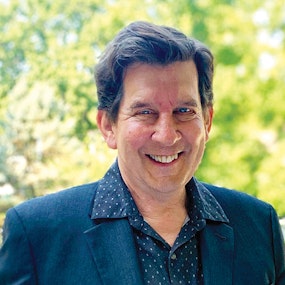
Patrick Murphy
Author, television producer
Patrick Murphy has spent the past 30 years producing television programs for PBS, both locally and nationally. A six-time Emmy award winner, he has created documentaries, weekly series, and musical variety shows. For the past 22 years he has hosted the St. Louis Speakers series from Powell Hall, interviewing more than 150 of the world's most renowned artists, writers, adventurers, and political leaders. He is also a working artist, exhibiting his collection of woodcut prints in galleries throughout the St. Louis region. He is the author of Candy Men: The Story of Switzer’s Licorice, The Irish in St Louis: From Shanty to Lace Curtain, and Places to Pray: Holy Sites in Catholic Missouri.
New to the Podcast? Start listening to some of these episodes!
You can check out episodes by topic or season at the top and bottom of the page.



















